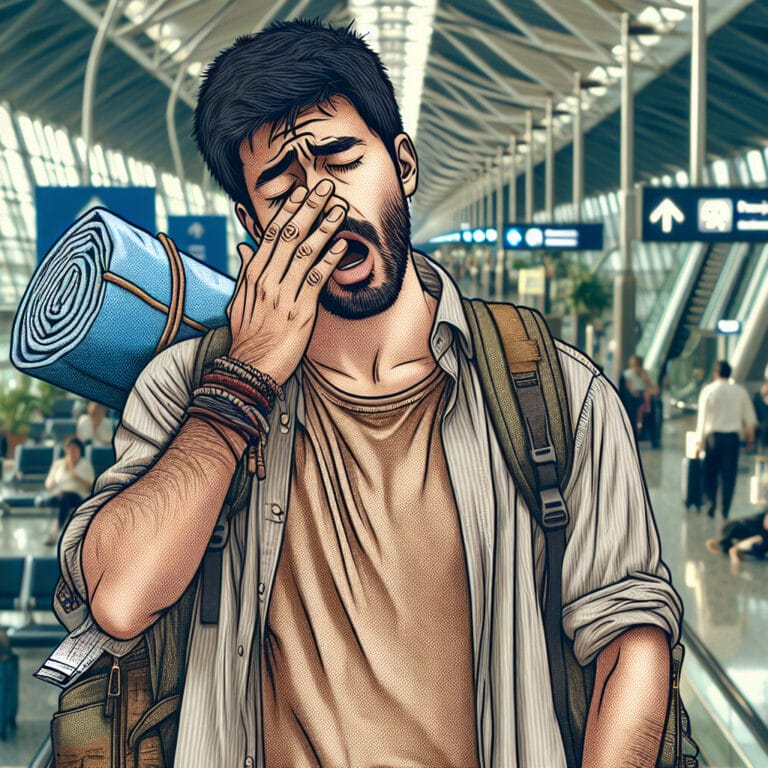
Understanding the Science: What Exactly Defines Jet Lag?
Table of Contents
- Understanding the Science: What Exactly Defines Jet Lag?
- What is Jet Lag?
- Causes of Jet Lag
- Symptoms of Jet Lag
- How to Prevent Jet Lag
- Conclusion
- Frequently Asked Questions
Understanding the Science: What Exactly Defines Jet Lag?
A surprising statistic reveals that nearly 93% of travelers experience jet lag at some point, which emphasizes the significance of understanding and addressing this condition. Jet lag represents a temporary sleep disorder that stems from traveling across multiple time zones in a short period. It’s essentially our bodies playing catch up to a new locale’s time zone and daylight hours, causing disruptions in our circadian rhythms – the internal clock governing sleep-wake cycles. The more time zones crossed during travel, particularly for long flights eastward, the more severe jet lag symptoms can be. These symptoms range from fatigue caused by disrupted sleep schedules to cognitive impacts affecting mental health.
Preventing or reducing jet lag involves strategies that help synchronize your body clock with your destination’s local time before and after travel. For instance, gradually adjusting sleep-wake schedules to match the destination’s local time can aid in acclimatization. Using light exposure strategically is another method; maximizing daylight intake can promote wakefulness while light avoidance close to bedtime can promote sleep. Some people find using sleep aids helpful during an adjustment phase whilst others swear by napping briefly during unusual fatigue bouts.
Understanding these aspects provides a comprehensive guide towards managing jet lag effectively, reinforcing its importance not just for frequent travelers but also for shift workers who experience similar symptoms due to irregular work hours.
What is Jet Lag?
Jet lag, often a companion of long flights and abrupt transitions across time zones, is an intriguing subject in sleep medicine. It is essentially a disruption of our body’s internal clock or circadian rhythm—a finely-tuned mechanism governing our sleep-wake cycle. This rhythm aligns with local time and daylight hours under normal circumstances. However, when we cross multiple time zones rapidly while traveling, especially eastward, it throws off this delicate balance. The body requires time to adjust to the new ‘time rules’, leading to a range of jet lag symptoms.
Fascinatingly, light exposure plays a central role in these scenarios. Our circadian clock uses natural light as cues for wakefulness and darkness to promote sleep. So, when we are exposed to light at odd hours due to a sudden shift in timezone, it causes confusion within our circadian system—explaining those instances when you desperately want to fall asleep but can’t or vice versa.
Sleep disorders such as jet lag have broader implications beyond travel fatigue; they can impact mental health by causing cognitive impairment if recurring frequently or left unaddressed over long periods. As such, understanding and preventing jet lag not only offers relief for frequent flyers but carries importance for shift workers who experience similar symptoms due to inconsistent work routines that are at odds with their body’s desire for regularity.
Causes of Jet Lag
A surprising fact about jet lag is that despite its common occurrence, many people lack a comprehensive understanding of what it means and how to minimize its impact. Jet lag essentially occurs when our body’s internal clock or circadian rhythm, which governs our sleep-wake cycle, becomes misaligned with the local time of a new destination. This typically happens when crossing multiple time zones during long flights, especially while traveling eastwards. Light exposure plays a critical role in this scenario as our circadian rhythms use natural light for cues; daylight promotes wakefulness while darkness induces sleep. Therefore, abrupt changes in light exposure due to swift transitions across time zones disrupt these rhythms causing jet lag symptoms such as fatigue and insomnia.
However, reducing or even preventing jet lag is possible through strategic measures. These strategies include modifying your sleep schedule before travel to align more closely with your destination’s local time, maximizing exposure to daylight during waking hours and avoiding light closer to bedtime can help readjust the body’s internal clock faster upon arrival. Also incorporating brief naps or using sleep aids can be beneficial during the adjustment period post-travel.
In essence, comprehending and addressing jet lag not only relieves travel fatigue but also carries implications for mental health by preventing cognitive impairments related to recurrent disturbances in sleep patterns. It offers a broader perspective benefitting shift workers who experience similar symptoms because of inconsistent work schedules conflicting with their bodies’ craving for regularity.
| Cause | Explanation |
|---|---|
| Crossing Multiple Time Zones | This typically happens during long flights, especially while traveling eastwards, disrupting our body’s internal clock or circadian rhythm. |
| Changes in Light Exposure | Abrupt changes in light exposure due to swift transitions across time zones disrupt our body’s sleep-wake cycle, leading to symptoms of jet lag. |
| Solution | Explanation |
| Modify Sleep Schedule Before Travel | Adjusting your sleep schedule to align more closely with your destination’s local time can minimize the impact of jet lag. |
| Manage Light Exposure | Maximizing exposure to daylight during waking hours and avoiding light closer to bedtime can help readjust the body’s internal clock faster upon arrival. |
| Incorporate Brief Naps or Use Sleep Aids | These strategies can be beneficial during the adjustment period post-travel to mitigate jet lag symptoms. |
| Benefit | Explanation |
| Relieves Travel Fatigue | Understanding and addressing jet lag not only relieves travel fatigue but also prevents cognitive impairments related to recurrent disturbances in sleep patterns. |
| Benefits Shift Workers | Shift workers who experience similar symptoms due to inconsistent work schedules conflicting with their bodies’ craving for regularity can also benefit from these strategies. |
Symptoms of Jet Lag
Jet lag, a common accompaniment to long flights and rapid transitions across time zones, is more than just a nuisance; it has implications for both physical well-being and mental health. With an estimated 93% of travelers experiencing jet lag at some point, recognizing this condition’s impact on our lives is essential. This sleep disorder disrupts the circadian rhythms – our body’s internal clock that regulates our sleep-wake cycle – leading to fatigue caused by a mismatch between local time and our internal clock.
Imagine being wide awake in the middle of the night or struggling to stay alert during daylight hours – these are classic jet lag symptoms that can leave you feeling disoriented after a time zone change. When traveling abruptly, especially eastwards where days get shorter, your body adjusts to new daylight hours slowly. It’s like forcing yourself to fall asleep when you’re not tired or staying awake when you’re exhausted – your sleep schedule goes haywire.
However, there are strategies one can employ to minimize jet lag and help synchronize the body’s internal clock with the new local time faster. Adjusting your sleep-wake schedules before travel or even going to bed earlier can pave the way for smoother acclimatization upon arrival at your destination. Similarly, managing light exposure plays an important role – encourage wakefulness through maximizing daylight intake during waking hours while promoting sleep via light avoidance close to bedtime.
These measures not only reduce travel fatigue but also contribute positively towards mental health by preventing cognitive impairments associated with recurrent disturbances in sleep patterns – offering beneficial insights for shift workers who experience similar symptoms due their inconsistent work routines. This comprehensive guide aims to provide an understanding of how we can better navigate through such scenarios for overall well-being.
| Symptoms of Jet Lag | Potential Solutions |
|---|---|
| Disruption of sleep-wake cycle | Adjust sleep-wake schedules before travel |
| Feeling awake in the middle of the night | Try to adjust to the local time as soon as you arrive |
| Struggling to stay alert during daylight hours | Maximize daylight intake during waking hours |
| Disorientation after a time zone change | Go to bed earlier for smoother acclimatization upon arrival |
| Sleep schedule goes haywire | Promote sleep via light avoidance close to bedtime |
How to Prevent Jet Lag
While jet lag may seem like an unavoidable consequence of long-distance travel, understanding the fundamental role of our body’s internal clock or circadian rhythm in governing sleep-wake cycles provides a comprehensive guide for tackling this temporary sleep disorder. The disruption experienced is essentially a result of your body clock trying to synchronize with the local time of your new destination, especially when multiple time zones have been crossed. Just imagine – it’s like attempting to fall asleep when you’re not tired or staying awake when exhaustion has set in. This confusion can manifest as various jet lag symptoms such as fatigue caused by disrupted sleep schedules and even cognitive impacts affecting mental health.
However, there are strategic measures that one can employ pre-flight, in-flight and post-flight to minimize jet lag. For instance, adjusting your sleep schedule prior to travel can help acclimatize your body faster upon arrival at your destination – going to bed earlier than usual could be helpful here. Similarly, during the flight and upon reaching your destination, managing light exposure plays an important role; maximize daylight intake during waking hours while avoiding light closer to bedtime promotes sleep and reduces jet lag.
In cases where individuals still experience significant discomfort from jet lag symptoms despite these strategies, turning towards sleep medicine may provide relief. Sleep aids work by promoting drowsiness and thereby helping recalibrate the disrupted circadian rhythms back into alignment with local time.
So whether it’s making slight tweaks in our daily routines before travel or utilizing tools like sleep aids during extreme bouts of insomnia caused by abrupt time zone changes – comprehending how we regulate our internal clocks offers promising ways not only reduce travel fatigue but also maintain healthy mental states amidst timezone transitions.
Conclusion
Despite being a common occurrence, the complexity behind jet lag remains widely misunderstood. From long flights to rapid transitions across time zones, it’s more than just a travel nuisance – it has serious implications for our physical health and mental well-being. The root cause lies in the disruption of our body’s internal clock or circadian rhythm. However, by understanding these intricate mechanisms that govern our sleep-wake cycle, we can develop insightful strategies to alleviate the symptoms caused by this temporary sleep disorder. Proper light exposure management and adjusting your sleep schedule before travel can significantly reduce jet lag. Similarly, incorporating brief naps or using sleep aids during exceptional bouts of insomnia can provide relief and help recalibrate those disrupted circadian rhythms back into alignment with local time. Recognizing the impact of such sleep disorders extends beyond travel fatigue; they hold importance for shift workers who experience similar symptoms due to inconsistent work routines conflicting with their body’s craving for regularity. Harnessing this comprehensive overview not only helps frequent flyers but also contributes positively towards maintaining healthy mental states amidst timezone transitions.



